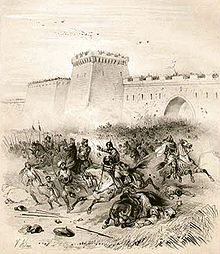Emirate of Bari
Emirate of Bari | |||||||||
|---|---|---|---|---|---|---|---|---|---|
| 847–871 | |||||||||
| Capital | Sawdan | ||||||||
| History | |||||||||
• Established | 847 | ||||||||
• Disestablished | 871 | ||||||||
| |||||||||
The Emirate of Bari was a short-lived
Foundation
Bari first became the object of
Rule of Sawdan
The third and last emir of Bari was Sawdan, who came to power around 857 after the murder of his predecessor Mufarrag. He invaded the lands of the
The
In 859,
The emirate of Bari lasted long enough to enter into relations with its Christian neighbours.
Fall

In 865,
It was not until the spring of 867 that Louis took action against the emirate. He immediately besieged
The joint attack was projected for late in the summer of 869 and Louis remained at Benevento planning as late as June. The Byzantine fleet—of four hundred ships if the Annales Bertiniani are to be trusted—arrived under the command of Nicetas with the expectation that Louis would hand over his daughter immediately.[14] This he refused to do, for no known reason, but perhaps because Nicetas had refused to recognise his imperial title, since Louis later refers in a letter to the commander's "insulting behaviour".[15] Perhaps, however, the fleet simply arrived too late in autumn.[15]
In 870 the Bariot Muslims stepped up their raids, going so far as to ravage the
List of emirs
- Kalfün (Khalfun), 841–c.852
- Mufarrag ibn Sallam, c.852–c.857
- Sawdan (Sawdān), c.857–871
Notes
- ^ Alex Metcalfe, The Muslims of Medieval Italy (Edinburgh University Press, 2009), p. 21: "there is an implication in [the name Sawdān] that he was originally from sub-Saharan Africa. A problematic reference to him in an unedited text ... again suggests that, like the previous commanders of the Muslim forces in Bari, they were not Arab."
- ISBN 9782857445098, retrieved 2019-02-06
- ISBN 9781849049351.
- ^ Kreutz, 25.
- ^ a b Kreutz, 38.
- ^ a b c d e f Kreutz, 39.
- ^ a b Drew, 135.
- ^ a b Kreuger, 761.
- ^ Much to the dismay of pious ecclesiastics like Bernard (Kreutz, 39).
- ^ a b c Kreutz, 40.
- ^ a b c Kreutz, 41.
- ^ Kreutz, 172, n26. The capture of the cities is referred to both in Erchempert and Lupus Protospatharius.
- ^ Kreutz, 42.
- ^ Kreutz, 43.
- ^ a b Kreutz, 44.
- ^ a b c d Kreutz, 45.
- ^ Kreutz, 173 n45.
- ^ Vedran Duančić; (2008) Hrvatska između Bizanta i Franačke (in Croatian) p. 17; [1]
Bibliography
Primary sources
The following are available as part of Sources of Lombard History at the Institut für Mittelalter Forschung:
See too the letter of Emperor Louis II to Emperor Basil I, written in 871 after the capture of Bari, in English translation.
Secondary sources
- Bondioli, Lorenzo M. (2018). "Islamic Bari between the Aghlabids and the Two Empires". In Glaire D. Anderson; Corisande Fenwick; Mariam Rosser-Owen (eds.). The Aghlabids and Their Neighbors: Art and Material Culture in Ninth-Century North Africa. Brill. pp. 470–490.
- Di Branco, Marco; Wolf, Kordula. (2013) "Berbers and Arabs in the Maghreb and Europe, medieval era". The Encyclopedia of Global Human Migration, ed. Immanuel Ness, vol. 2. Chichester, pp. 695–702.
- Kreutz, Barbara M. (1996) Before the Normans: Southern Italy in the Ninth and Tenth Centuries. Philadelphia: University of Pennsylvania Press. ISBN 0-8122-1587-7.
- Musca, Giosuè (1964). L'emirato di Bari, 847–871. (Università degli Studi di Bari Istituto di Storia Medievale e Moderna, 4.) Bari: Dedalo Litostampa.
- Drew, K. F. (1965) Review of L'emirato di Bari, 847–871, Giosuè Musca. The American Historical Review, 71:1 (Oct.), p. 135.
- Krueger, Hilmar C. (1966) Review of L'emirato di Bari, 847–871, Giosuè Musca. Speculum, 41:4 (Oct.), p. 761.
